Family : Araceae

Text © Prof. Pietro Pavone

English translation by Mario Beltramini
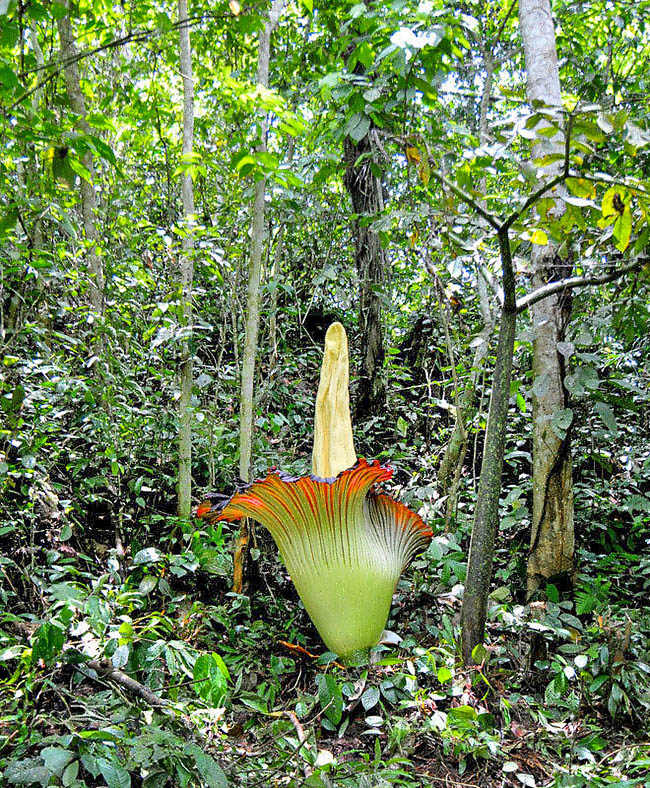
Discovered by the Florentine naturalis Odoardo Beccari in 1878, Amorphophallus titanum is a species endemic to Sumatra forests growing on fine grained volcanic rocks in semi-shaded areas at 200-450 m of altitude © save_titan_arum_project
The ever bigger male flowers Amorphophallus titanum is a plant discovered by the Florentine naturalist Odoardo Beccari (1843-1920) during his third voyage in the Far East begun in 1877. After having visited India, Malaysia, Australia, Tasmania and New Zealand, in May 1878, leaving from Java, he made a five months exploration in the mountainous forests of Sumatra (Indonesia).
Beccari discovered this species on August 6th, 1878 on the western coast of the island but was not in flower it was in fruitification and gave it the name of Conophallus titanum Becc.
However he was curious to see this plant in bloom so he put a reward on the flower. After a short time, two men arrived, carrying on their shoulders what looked like a huge flower.
Beccari defined it “a gigantic and monstrous flower”.
In reality it was an inflorescence whose spadix measured 1,75 m and the spathe had a diametre of 83 cm and was 70 cm deep. According to these characteristics he himself renamed the plant in Amorpophallus titanum. However, in the manuscript given to print, due to a misunderstanding, the first name remained (Bull. Soc. Tosc. Ortic. 1878, Vol. 3:271).
It was up to Giovanni Arcangeli (1840-1921) to formally attribute the name of this plant assigning it to the genus
Amorphophallus with the combination Amorphophallus titanum (Becc.) Becc., 1879. In the publication he also made the complete description based on materials and notes done by Beccari (Bull. Tosc. Ortic. 1879 Vol.4: 46-51).
The genus Amorphophallus Blume belongs to the family Araceae and presently regroups about 200 species of palaeo tropical plants distributed in Africa, Madagascar, India, south-eastern continental Asia, Malaysia and north-eastern Australia with main diversity centre in south-eastern continental Asia and in western Malaysia.
Amorphophallus titanum is a species endemic to the island of Sumatra (Indonesia), present in semi-shaded areas of the tropical forests at an altitude varying from 200 to 450 m above the sea level. It is found on fine-grained volcanic rocks (trachytic rocks), alkaline, in steep areas with high humidity (92.87%), average light intensity of 647,19 lux and average temperature of 23,09 °C.
In its habitat is present tree vegetation dominated by Elateriospermum tapos Blume, (Euphorbiaceae), whilst in the underlying layer is found Ficus hispida L.f. (Moraceae) and in the herbaceous one Selaginella plana (Desv.) Hieron (Selaginellaceae).
Unluckily this species is threatened in its range by the harvesting of wood and by the creation of oil palm plantations. Moreover, often the countrymen destroy this plant, when they find it in their agricultural lands, because there is the popular belief that the spots on the petioles of the leaves are like those of a snake and therefore consider it dangerous.
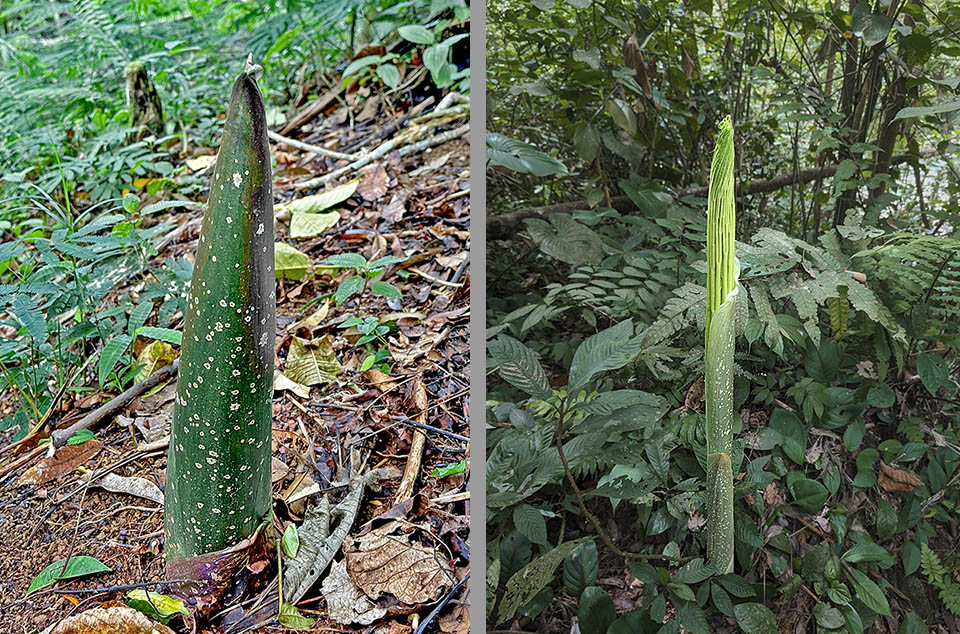
From the seed germination forms only one leaf with pale green petiole with whitish spots that rises vertically from the soil © naturalistnkc (left) and © Daniel Roberts (right)
Recently the species is legally protected in Indonesia and has been, in 2018, declared by the IUCN Red List of the Endangered Plants as in danger (EN Endangered).
The etymology of the generic name Amorphophallus comes from the old Greek ἄμορφος amorphos, shapeless, deformed and φαλλός phallos, phallus. The specific epithet refers to Τιτάν Titan, titan, giant due to its imposing inflorescence. Commonly it is known as Titan arum, Giant arum, Corpse flower, Corpse plant and Bunga bangkai in Indonesia.
Amorphophallus titanum is a large herbaceous plant that may reach 30-40 years of age. It has an underground tuberiform rhizome, sub-spherical in shape, that, depending on the age, has variable size and may reach a diametre of 50 cm.
From the germination of the seed forms only one leaf with the petiole rising vertically from the ground and, in the bigger specimens, it can reach the length of 3,5 m. It has a cylindrical shape, with smooth surface, of pale green colour with whitish spots, circular and thick, that render it similar to the bark of the trees covered by lichens. In its apical part the petiole divides into three branches, more than 3 m long, that divide several times until they expand in pinnatisect laminae, supported by veins protruding in the lower pagina, whose membranous segments are ovate and pointed at the top, some decimetres long and 10-14 cm broad.
The sugars forming during the photosynthesis accumulate in the underground tuber in the form of starch.
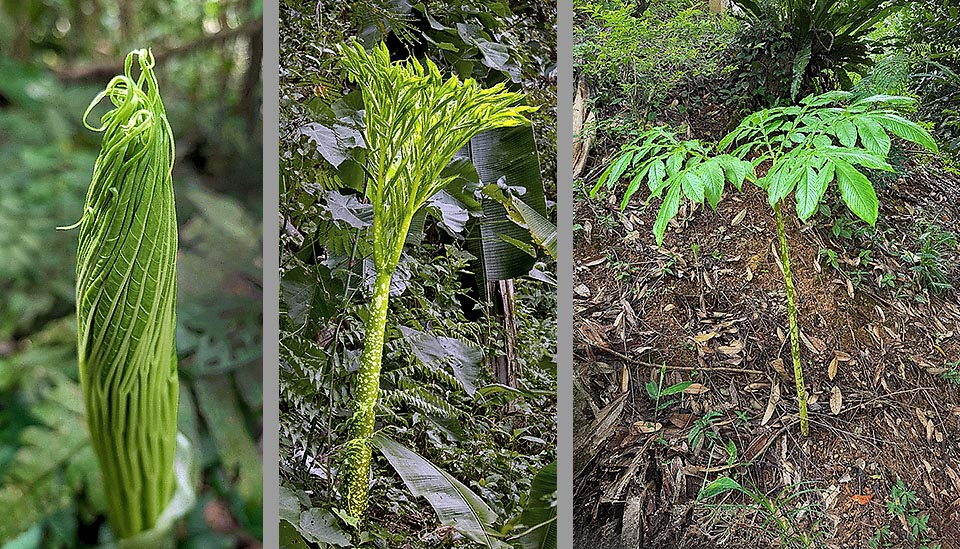
The petiole apex unrolls expanding in pennate-sect laminae, supported by veins protruding in the lower pagina, with ovate and sharp at apex membranous segments, some centimetres long and 10-14 cm broad. The sugars forming from the photosynthesis accumulate in the time under form of starch in an underground gigantic tuber. From left © Daniel Roberts © Luke Mackin © naturalistnkc
After a period of about one year, the old leaf dies and the tuber enters a dormant status for about four months. Later on from the tuber gets out another leaf that repeats the cycle furnishing other nutrients to the tuber. This process may go on for several years (up to seven) swelling the tuber that, sometimes, may reach the weight of 90 kg.
This is the biggest tuber of any known flowering. When the tuber is big enough, at the place of the leaf a large inflorescence forms. Blooming after about 10 years since sowing, whilst the following bloomings can take place at intervals varying from two to seven years.
The flower stalk (scape) is leafless, plain, smooth and stained like the stalk, about 50 cm long and even more than 10 cm broad. At its apex forms an about 70 cm huge bell-shaped bract (spathe), progressively widened from the base towards the apex with an often serrated margin.
The spathe, whose diametre may reach up to 80 cm, has a protective function for the inflorescence and acts as a call for the pollinators. On the outside it is green in colour whilst inside is purple. Inside the spathe is present the spadix (a fleshy spike inflorescence) with the enlarged axis that in some specimens can reach the length of about 1,50 m.
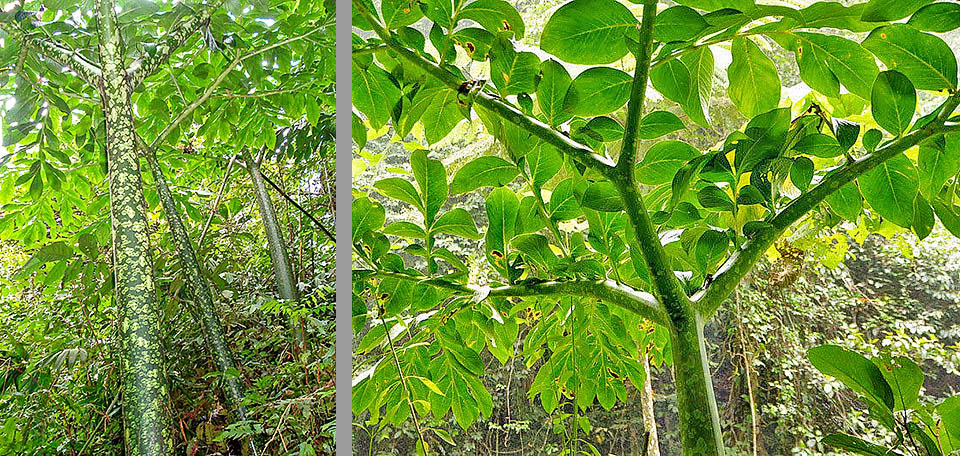
After about one year, the old leaf dies and the tuber enters a dormant status for about four months. Then produces a new leaf ever bigger that repeats the cycle further nourishing the tuber. A process lasting even 7 years with a tuber that may reach 90 kg © sergey_stefanov (left) and © save_titan_arum_project
In its basal portion are inserted several sessile unisexual flowers. The female ones are placed below, in the cylindrical portion, whilst the male ones are located higher in a portion shaped like a spinning top with a rather protruding strip.
The female flowers are numerous and close together with globose and conical ovary surmounted by a purple red style, twice as long as the ovary and with a yellowish hemispheric stigma. The male flowers are only stamens with short and thickened filament and globose, bilobate anther. They are close to each other forming a layer covering the upper fertile surface of the spadix.
Over the reproductive organs, the spadix extends in the shape of a cone of dirty yellow at times red-violet colour. When the spathe opens, the inflorescence is foul-smelling. The particularly unpleasant odour is emitted for the duration of the flower lasting an average 3-4 days. It is caused by the presence of various compounds among which the main is the dimethyl trisulfide (DMTS), organic chemical volatile compound with chemical formula CH₃SSSCH₃. It has a very low threshold and has a typical odour of fetid meat.
Moreover, it has been documented that the inflorescence undergoes a thermogenesis. In fact, the male flowers reach a temperature of 35,9 °C, whilst the other parts of the plant have a room temperature of 26 °C. The warm temperature that forms on the spadix creates a thermal convection with the cool air of the environment to better spread the putrid odour that, together with the bright red colour of the spathe (similar to raw meat), attracts the insects that feed on carrions. This deceptive attraction ensures the pollination of the plant.
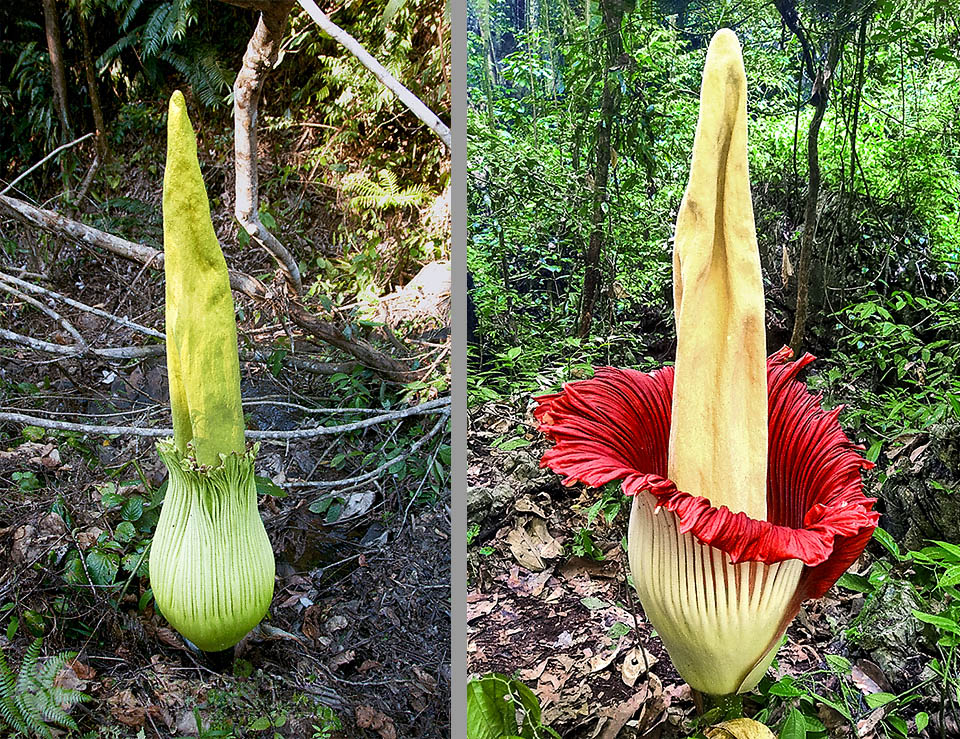
When the tuber is big enough, at the leaf place, forms a large inflorescence. From left © save_titan_arum_project and © Yash Bhagwanji
The female flowers open first and only after one or two days the male flowers will open. This phase displacement serves to prevent the self-pollination, even if it is possible that, at times, this may occur. In fact, the styles are curved upwards getting the stigmas closer to the anthers above that, opening, can drop pollen over them.
Several Authors have studied the pollinators of Amorphophallus titanum but with significantly different results. Stingless bees have been seen during the second day of anthesis and no insects on the first day. Other Authors report having seen beetles like Diamesus osculans (Vigors, 1825) (Silphidae) and Creophilus flavipennis (Hope, 1831) (Staphylinidae). Finally, more recently, in Sumatra, have been reported, on different inflorescences, beetles belonging to the families Curculionidae, Histeridae, Hybosoridae and also other presumed pollinators and occasional visitors such as diptera, ants, cockroaches and spiders.
The fruits are numerous, ellipsoidal in shape, with the size of a plum, of deep red colour. They have a pulpy pericarp and contain 2-3 seeds, externally greenish, elongated, with outer face convex and the inner flat, at times keeled.
Beccari, in addition to divulging his discovery, sent in Europe seeds and tubers of this plant with the aim of making it known to the scholars. In fact, he sent to Sir Joseph Dalton Hooker (1817-1911), via the Marquis Bardo Corsi Salviati, a small tuber of Amorphophallus titanum.
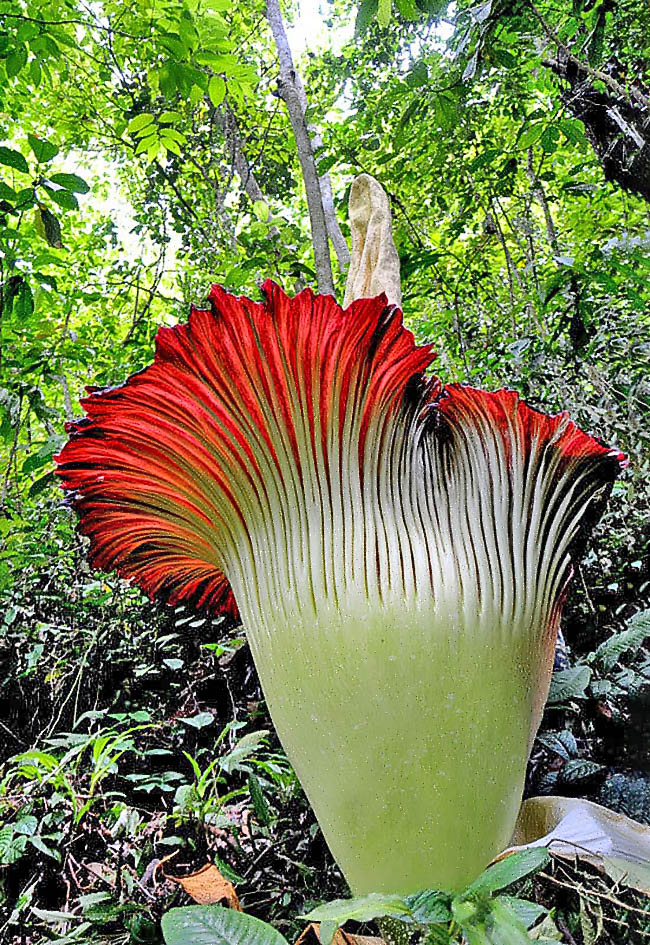
The spathe that may reach 80 cm in diametre protecting the inflorescence, the spadix, even 1,50 m long © save_titan_arum_project
Whilst the seedlings cultivated in Sesto Fiorentino (Florence), in the greenhouses of the Villa Corsi Salviati, passed away all before reaching the blooming, the tuber sent to Hooker, who placed it in a pot at the centre of a large pool inside the warm greenhouse of the Royal Botanic Gardens of Kew, flowered in 1889 June.
This blooming, for the first time in Europe, impressed thousands of visitors so much that the British press called the event: One sensation of the London Season.
In the USA the first blossomings occurred in 1937 and in 1939, in the New York Botanical Garden.
In Germany, the Botanischer Garten in Bonn had, from 1937 to 2009, fourteen bloomings that, in optimal growing conditions, occur every two years.
In the University of Copenhagen Botanic Garden from 2003 is present a plant of Titan arum that began to bloom in 2012 and blooms approximately every two years.
In New Zealand the first blooming happened in 2013 in the tropical greenhouse of the large Auckland Domain Wintergardens. While in Dunedin Botanic Garden a blooming took place in 2018.
Bloomings happened also in the three botanical Indonesian gardens: Bogor Botanic Gardens, Cibodas Botanic Garden and Purwodadi Botanic Garden.
In Italy, at the Florence Giardino dei Semplici, the Titan arum has bloomed twice, in 2002 and in 2007. This specimen comes from a seeds collection done during two scientific missions carried on in 1994 and in 1995 in the western part of Sumatra Island.
In August 2025, the Titan arum opened in the Warsaw University Botanic Garden attracting many persons despite its strong odour of rotting flesh. And so happened in the tropical greenhouses of the Jean-Marie Pelt Botanical Garden (Villers-lès-Nancy, France), where flowers developed in 2023 and 2025 from plants donated in 2018 by the Meise Botanical Garden (Belgium).
With the purpose of sustaining its conservation, Amorphophallus titanum is grown in more than ninety Botanic Gardens with about 500 specimens that represent about half of those left in nature.
In 2018, the United States Botanic Garden Washington, in collaboration with the Botanic Garden Conservation International (BGCI), has financed a conference on the conservation of the Araceae’s to which have participated experts from the whole world. As a consequence of this event the Chicago Botanic Garden has taken over the function of leader of a project with other Botanic Gardens for the study and the conservation ex situ of Amorphophallus titanum.
Karyological studies have evidenced that the karyotype of Amorphophallus titanum is formed by 26 chromosomes of which sixteen are metacentric, six are sub-metacentric, four are sub-telocentric, one of which with satellites. The karyotypic formula is z = 2n = 2x = 26 = 2M+14m+6sm+3st+lsts.
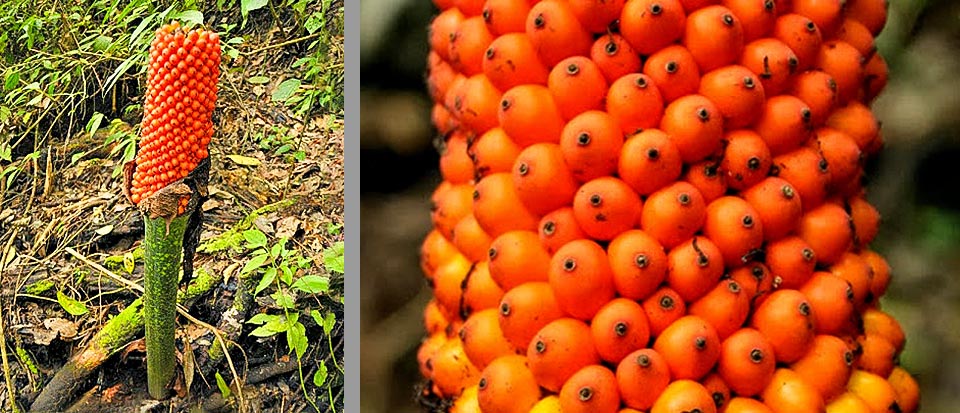
The fruits, containing 2 seeds, are numerous, of intense red colour, of ellipsoidal shape and size of a plum © save_titan_arum_project
All plants cultivated in the Botanic Gardens originate from only twenty individuals originally collected in nature and therefore they are genetically similar to each other and for this reason they do not offer sufficient guarantee for the conservation of the species. In order to face this challenge, the scholars are trying to modify the genetical base of the plants in cultivation through selective breeding with individuals coming from different genetical lines. The collaboration between botanical Gardens is consequently essential to preserve genetically this species. Moreover, they are moving forward with programs of reintroduction in protected natural habitats, with the purpose of reinforcing the wild populations and ensuring their survival in the future.
In cultivation Amorphophallus titanum requires a soil with a moderate but constant input of humidity (semi-humid soil) rich in nitrogen, potassium, phosphorus and small amounts of sand for a good drainage.
The roots tend to rot if with too much water and to dry out in excessive dryness. Being an undergrowth plant it fears direct sunlight and the strong wind, preferring covered positions. The optimal growth temperature is of 23 °C, with variations no less than 15 °C and no more than 30 °C.
Synonyms: Conophallus titanum Becc. in Arcangeli3: 271 (1878); Amorphophallus selebicus Nakai in Bull. Tokyo Sci. Mus. 22: 1 (1948).
→ To appreciate the biodiversity within the ARACEAE family, please click here.
